Japan | Sky Tree, Tokyo
BY PARIS SUMPTER
Paris explores the Sky Tree tower in Tokyo.
Paris Sumper studied abroad in Tokyo, Japan, in Summer 2017: http://eap.ucop.edu/OurPrograms/japan/Pages/language-and-culture-ICU.aspx
BY PARIS SUMPTER
Paris explores the Sky Tree tower in Tokyo.
Paris Sumper studied abroad in Tokyo, Japan, in Summer 2017: http://eap.ucop.edu/OurPrograms/japan/Pages/language-and-culture-ICU.aspx
BY BARRY YANG
The Way of the French
When I arrived in France I spoke absolutely no French. Now, approximately a month later, I still speak no French. Well that is an exaggeration, but my comprehension and conversational skills are still very very very low. Unfortunately, the language class offered at Sciences Po Lyon does not contain a beginner’s level. Students with similar levels of French are bunched up in one class. Since everyone speaks mountains more French than me, the lowest level class is still 100 times passed my comprehension level. However, as the French say, c’est la vie.
This brings me to our French language instructor Professor Christophe. A curly haired friendly French man who largely refuses to speak English in class, Professor Christophe has a tendency to call on me to answer questions when he very well understands that my French skills are impoverished. I found the class initially very boring as I understood little to nothing that was going on. However, as time went on, Professor Christophe and I developed a friendly relationship filled with lively incoherent conversations that involved him partially understanding my English and me not understanding his French at all. Even though there is a huge language gap and a steep learning curve, I am having a great time in this class. Professor Christophe is a very nice teacher and takes the time to individually teach me the pronunciations and make sure that I’m not completely clueless as to what is going on. A soft spoken yet firm teacher, Professor Christophe is a lot of fun and has a good sense of humor. I am very glad that he takes my jokes well and enjoys my random comments in English (at least I hope he does). I could not be happier that I am learning French from him, and I really respect and appreciate the effort he puts in both in and out of class to ensure that he is able to help and advance every student regardless of the their French levels.
Yvan celebrating his birthday!
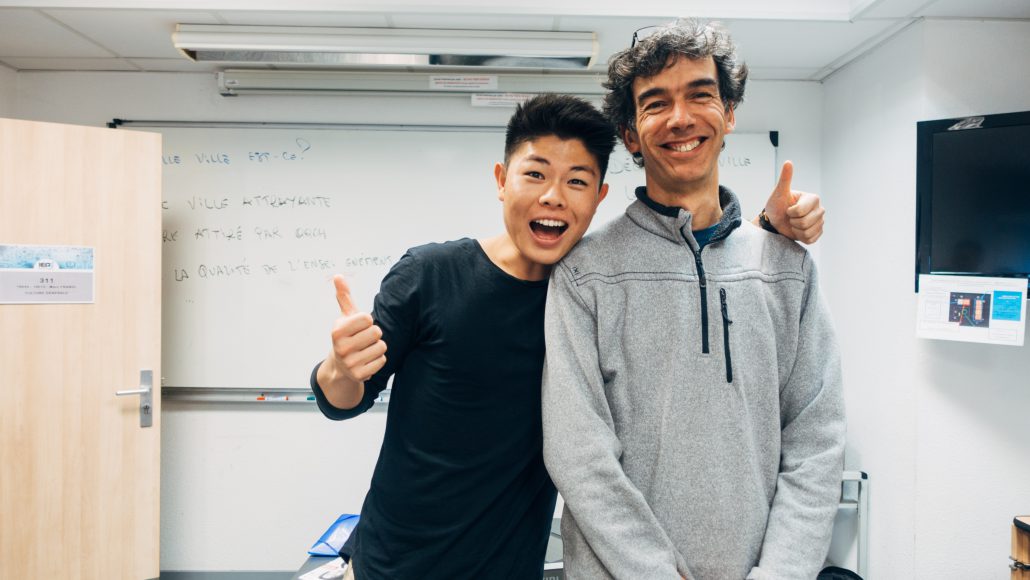
MEET MY FRENCH BROTHER PAUL-ELIOT
I have seen a lot of French students in the streets of Lyon, but none have been as inappropriately funny as my French home-stay brother Paul-Eliot. A 15 year old boy of many not so politically correct and PG jokes, Paul- Eliot constantly shows me French memes and translates them into English for me. I thoroughly enjoy helping him with his English homework and giving him a hard time whenever his teacher gives him a bad mark (all in good fun of course).
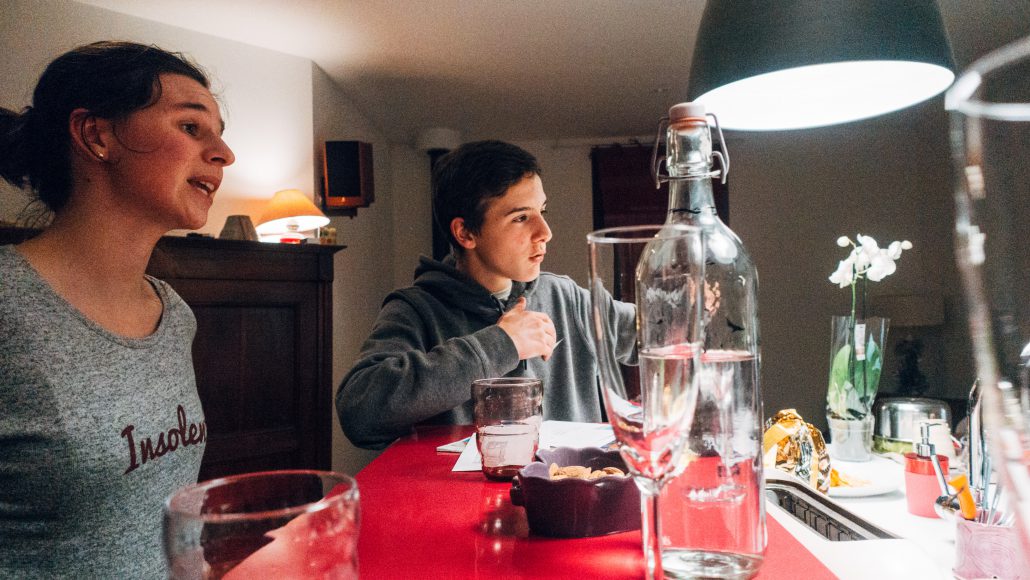
For a 15 year old, Paul-Eliot stays pretty busy. On Thursdays he has almost 9 hours of class and every Wednesday he does not get home from his “Fireman” activity until 8:30PM. Apparently, in France, the Firehouse holds activities where students can go to learn the duties of a fireman and engage in some exercise and workouts. The Firehouse also puts on a “Fireman Ball” where members of the community and participants of the Fireman class are invited to a soiree filled with small eats and dancing. My host family regularly attends; sadly I was not able to join this time because of my trip of Avignon.
Paul-Eliot is just one of the many great characters in my French family. Stay tuned for next week when I introduce my French sister Lison.
A WEEKEND IN ANOTHER SMALL TOWN
If one follows the Rhone river towards the Southern region of France, past Lyon, one arrives in a region known as Provence. While extremely beautiful during the summer, the sights during the winter are not so shabby either. A region that produces some great wines and picturesque postcards, Provence has been one of mine and my girlfriend’s favorite regions. In addition to being very beautiful, the region is also very cheap to get to via Flixbus, Ouibus, or Ouigo. For around 9-12 euros, you can make your way to some beautiful French towns and get away from the humdrum of the cities.
This weekend we visited Nimes, which is only about an hour away from Avignon (our choice of travel for last week). The city is very small, but has some amazing Roman architecture scattered throughout the town. In addition to a small pantheon, there is a very big Colosseum as well as beautiful statues. 20 kilometers outside the city is Pont du Gard. Pont du Gard is the highest of all elevated Roman aqueducts and listed as an UNESCO World Heritage Site for its historical significance. The aqueduct was built as part of a 50 kilometer water system that carried water from a spring at Uzes to the Roman colony of Nimes. At almost 50 meters tall, Pont Du Gard is an amazing architectural feat. It is hard to believe that people were able to build something of this caliber in the first century AD without heavy machinery or tools. That is Roman ingenuity I guess.
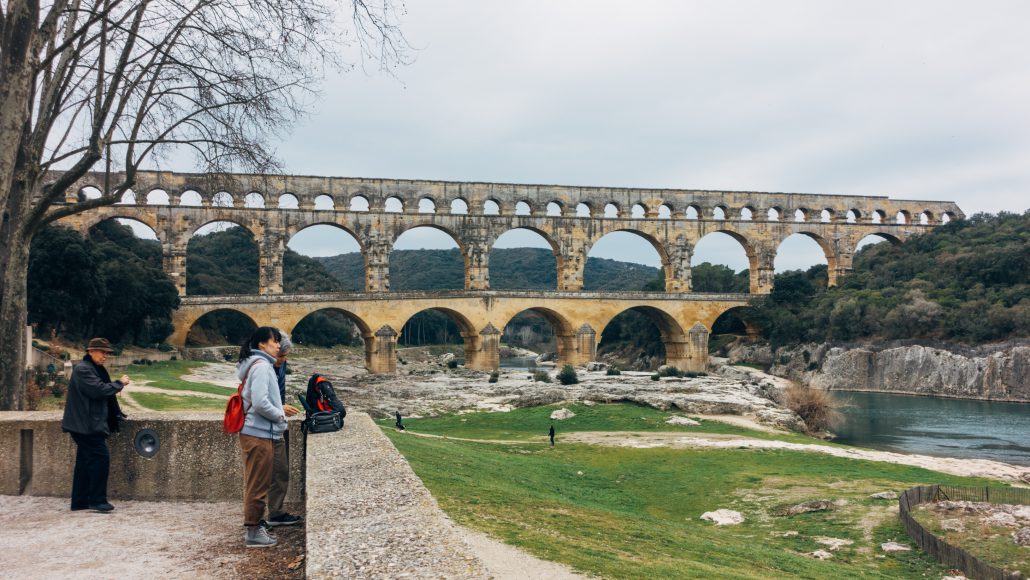
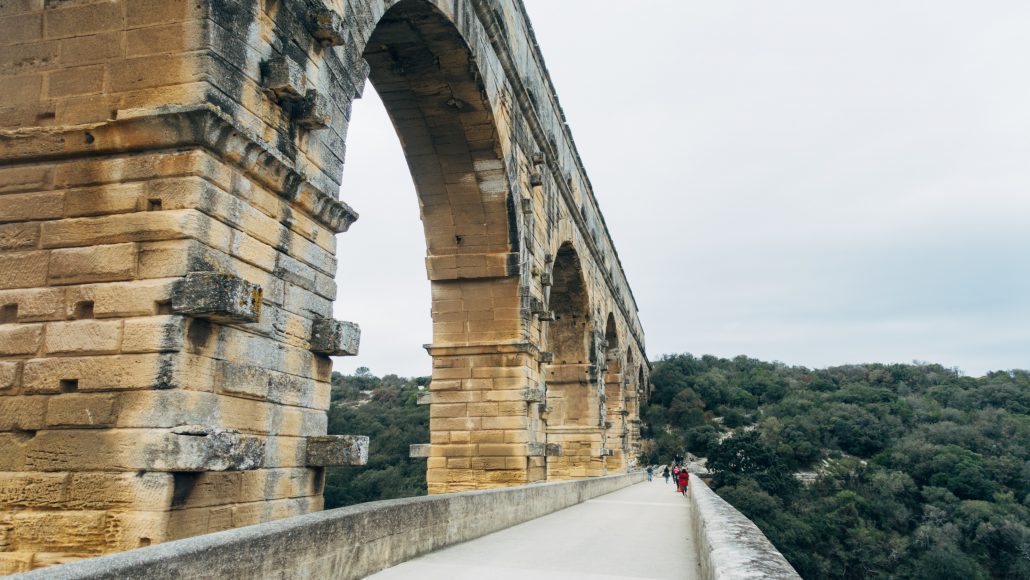
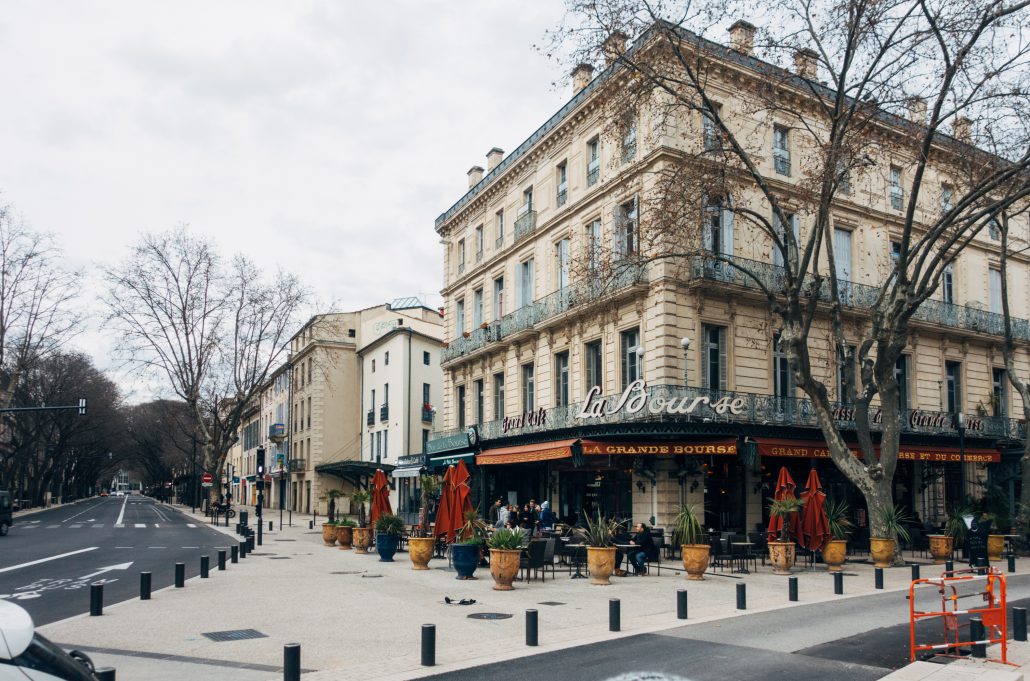
In addition to Pont du Gard, Nimes is just incredibly quaint and cozy. The buildings are extremely close together and the streets very narrow. With only 140,000 inhabitants, the city is sparsely populated despite its small size and there are few crowds like the ones one would see in Lyon or Paris. The public transit in the town should not be disregarded simply due to the city’s size. At only 160 square kilometers, Nimes has arguably a better public transport system than some of the biggest metropolises in the United States. The buses run every 7 minutes and only costs 1.5 euros for a ticket. One can easily get all around town on the bus, and there is little need to own a car. There is even a more extensive transport system that will take you to near by towns such as Uzes, Ales, and Poet du Gard for the same 1.5 euros. Overall, Nimes is a beautiful city and definitely worthy of at least a day trip.
I got the opportunity to fly my drone and make a video of the small city; the video can be found here: https://youtu.be/dSIgv9QDVVU
Barry Yang studied abroad in Lyon, France, in Spring 2017: http://eap.ucop.edu/OurPrograms/france/Pages/default.aspx
BY CELIA CODY-CARRESE
It’s dark when I leave my house at 7:20 am, travel backpack on and umbrella in hand, in case it rains in Granada. Our program is meeting near a park, where the streets are somewhat maze-like, and thus I walk in the wrong direction. Right about when I figure out that I am not going where I should be, I run into three other students who are in the same boat. We put our heads together and find our way to the bus, chuck our stuff in the storage compartment, and get settled for the two and a half hour ride to Granada.
For our Friday excursion during week three, we went to Granada to visit the Alhambra palace. Since the bus was already taking us there, most of the program decided to stay in Granada till Sunday, to further explore the city. But first, the Alhambra.

Fun fact: The Alhambra is the most visited monument in Spain! The palace which represents the last great Muslim kingdom in Europe drew over 2.4 million people in 2014. The Alhambra began as a small fortress and was expanded into a palace in the mid 13th century by the Moorish emir, or leader, at the time. In 1492, once Fernando and Isabel had expelled the Muslims out of Spain, they used the Alhambra as their Royal Court. They made a few changes to the complex, but overall the Alhambra is a stunning example of Muslim architecture. The palace boasts grand rooms, gardens, reflective pools, and a lot of intricate ceilings and arches- my favorite architectural details. The walls and ceilings all have extremely detailed inscriptions in Arabic, as well as carvings of geometric shapes, fruits and flowers, and other beautiful details. Part of the Alhambra complex is the Medina, which was a town where people who created products or worked to support the operations of the palace lived. Walking through the Medina’s pathways and gardens feels like a medieval fairytale.
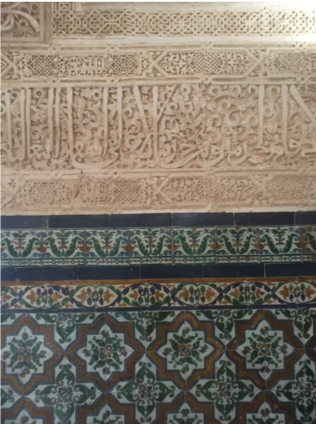

After the Alhambra, we headed to our hostels- I stayed at Marakuto hostel in Granada’s Albaicín neighborhood, a hilly and cobblestone lined maze of narrow streets. (The cobblestones in Granada are very charming but also very small and bumpy, hence the title of this blog- after a weekend of walking probably about 7 or 8 miles a day, my feet were pretty sore-worth it though!) Our hostel had hammocks and a treehouse, and after dropping off our things we joined a walking tour Marakuto provides. We walked through the Albaicín to several lookout spots, including an old house with a patio and a great view of the Alhambra. Then we made our way to the hills of Sacramonte, another old neighborhood in Granada. At the northern edge of the city, Sacramonte is at the base of a large hill, which you can walk up to get an amazing view of Granada and the Alhambra. We went at sunset and had the most beautiful view of the city and the sky. The golden, glowing lights of the Alhambra and the city slowly took over for the sun before our eyes.
The treehouse at Makuto hostel!
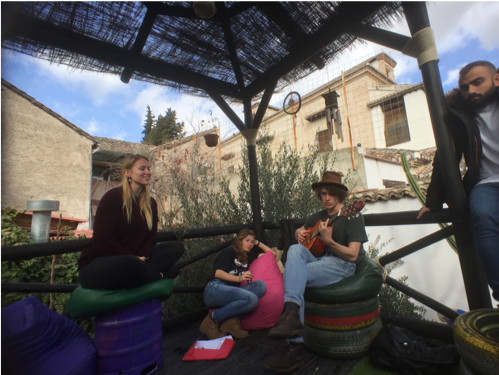
View of Granada and the Alhambra (on the far left) at sunset
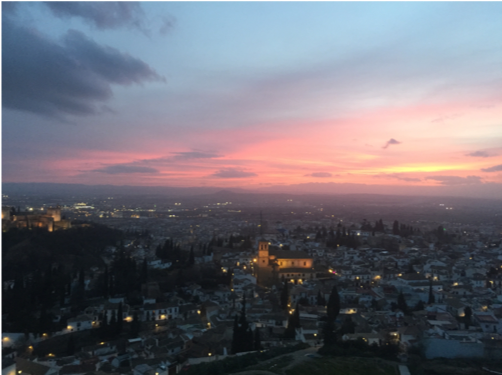
After a much needed hour of relaxing at our hostel, we got ready to go out for tapas! In Granada the tapas are legendary because they are almost always free, and they are also supposed to be some of the biggest tapas you can get in Spain. I personally didn’t have any enormous tapas, but some of my friends did! After two bars we had a sufficient dinner, for super cheap. (Side note: I am going to miss a lot of things about Spain when I go back to California- but I think one of the hardest adjustments is going to be paying for food! Everything here is so much cheaper than in the US!) After tapas we met up with some other students in our program and went out dancing- and like typical Spaniards we took our time getting home.
The next day we went explorin’! After toast and coffee at the hostel, I went with a friend to the center of Granada. First we saw the Capilla Real, or Royal Chapel, which is part of the Catedral de Granada (the free part, to be exact). Fun fact: Fernando and Isabel, the king and queen who expelled the Muslims from Spain, funded Colombus’s expedition, and expanded Spain’s empire in Europe and the “new world,” are buried in the Catedral de Granada. We had a pretty special moment in the Capilla, because the choir was having rehearsal while we were visiting. It’s really incredible to be in a beautiful church while such haunting and divine music is being sung 50 feet away from you.
Altar of the Capilla Real
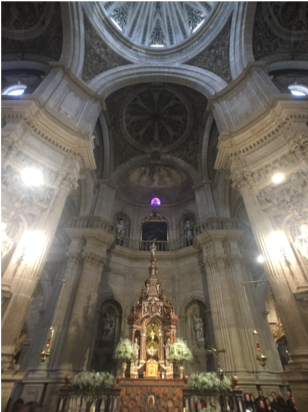
Patio in the Albaicín
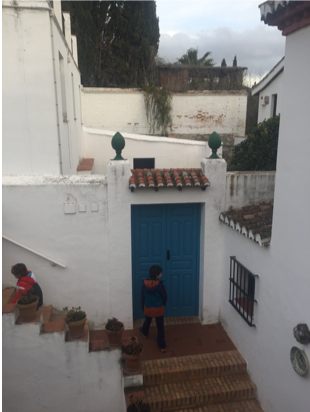
After the Capilla we walked around the Realejo, the old Jewish quarter of Granada. For some reason this neighborhood has a lot of graffiti, and me and my friend tried to see how much of it we could translate! After walking around we met up with some friends at a really good brunch place, Baraka, and I had my second breakfast of the day. Sometimes, one breakfast just isn’t enough. For the rest of the afternoon, we went to a park, explored the city by foot, and then returned to our hostel for some much needed R&R!
For our second and final night in Granada we went out for tapas again, of course, this time with some new found friends from our hostel. We had quite an international group-with us were people from Denmark, Argentina, Germany, and England! To maximize our options we went to Calle Elvira, a street lined with tapas bars at the base of the Albaicín neighborhood. There were probably about 10 bars and 5 kebab places (kebab and falafel are the go-to late night foods in Spain) in three blocks on Calle Elvira! We went to one bar for a bite to eat and then later to a few places for dancing. Fun fact: It’s fairly common for bars in Europe to have foosball tables, which you can pay a euro for and get about 5 balls to play with. I played with some of our friends from the hostel- who were all way better than me because they play a lot, whereas I haven’t played since I was maybe 15.
For my last day in Granada, I met up with more people in our program to enjoy the city. There is a lot to do in Granada but it’s really quite beautiful to just walk around, you’re bound to run into something interesting! We went into a church and also by a creek that runs below the Alhambra. Afterwards we got churros con chocolate and ice cream before hopping on the bus back to Córdoba!
My time in Granada was truly magical, the city as a whole is historical and beautiful, at the same time grungy and kitschy. Every street holds new smells, sounds, and sensations. I can’t wait until I can go back!
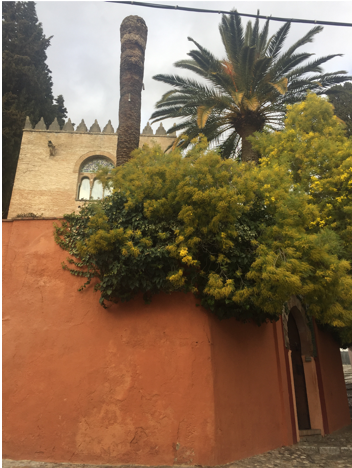
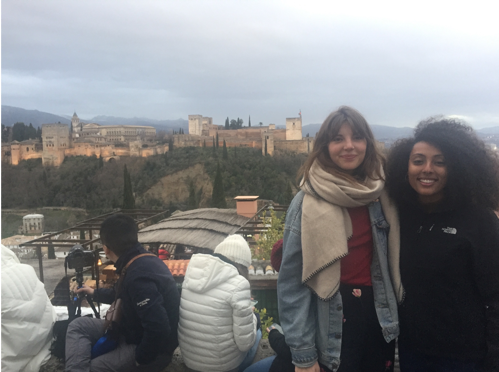
Celia Cody-Carrese studied abroad in Cordoba, Spain, in Winter 2017: http://eap.ucop.edu/OurPrograms/spain/Pages/exploring_andalucia.aspx
Kylee Bauer studied abroad in Ghana in Summer 2018: http://eap.ucop.edu/OurPrograms/ghana/Pages/summer-in-ghana.aspx
BY SEBASTIAN FLORES
Sebastian Flores studied abroad on the 2015 Summer Travel Study International and Area Studies program in Cuba.
BY GRACE HEART
LEAPCARD/BUS SYSTEM
The easiest way to get around the city is through the bus system. Each student is given a LeapCard upon arrival at the program and it is preloaded with €5. With the LeapCard, you don’t have to worry about carrying exact change around wherever you go. Instead, you just fill up your LeapCard in advance and you’re good to go whenever you’re ready to explore.
The best place to fill up your LeapCard is at the Centra on campus before you leave. I try to have at least €10 on my card at all times in case I end up going anywhere I didn’t expect to go. On average, each ride usually costs about €2.05 with some of the longer trips being more. It is possible to fill up your LeapCard online, but DON’T DO THIS! If you fill up the card online, you have to take it in to Centra to verify the transaction anyway, so just save yourself the time and effort and go straight to Centra.
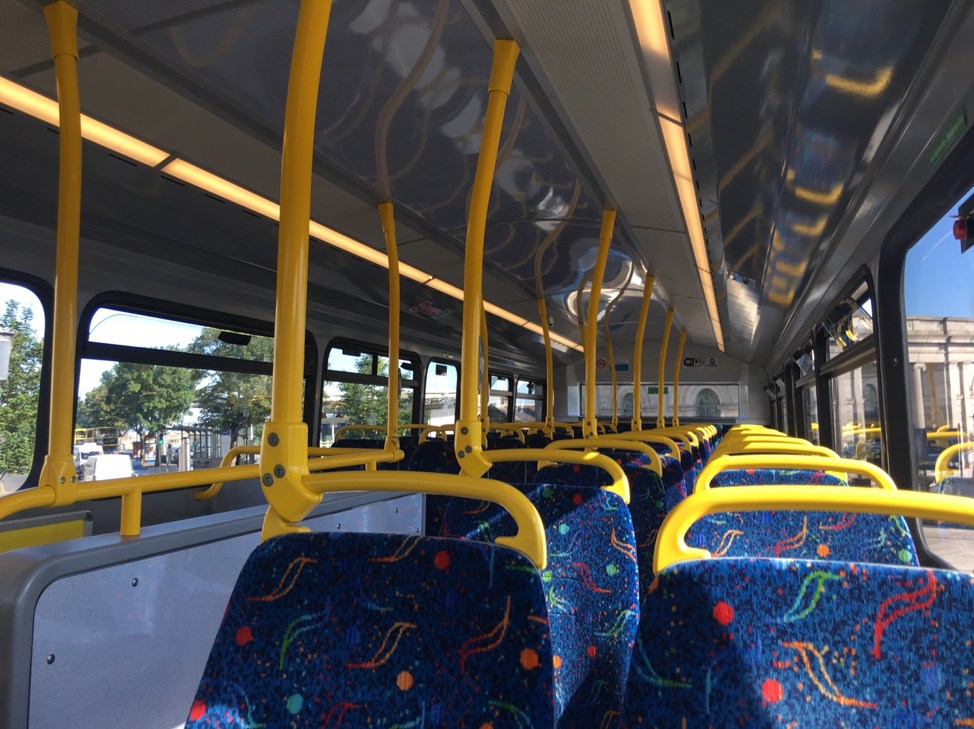
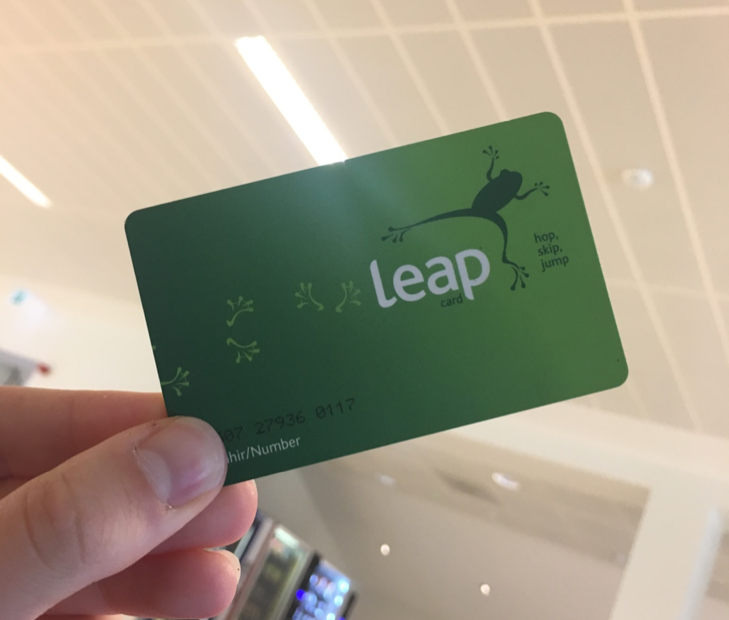
When you get on the bus, you can either “tap on” in which case you pay the max fee for all the stops or you can tell the bus driver your stop and he will only charge you according to the number of stops you will be going. Most times, I just tap on, especially if its crowded, to save time, but if you are only going a few stops, just let the bus driver know so you don’t get charged for the whole trip.
I know this was a point of confusion for several people when we started using the bus system, but some people were told that they needed to “tap off” if they “tapped on” when getting on the bus, but you DO NOT NEED TO TAP OFF. Some of my friends got charged a lot of extra money by making this mistake. Tapping off will charge you AGAIN for the max ride length which I’m sure you don’t want. When exiting the bus, you do not have to do anything.
Keep in mind that the bus stops running at 11pm usually. If you are going to be out after 11pm, just split a taxi with your friends. We’ve found it to be about €15-18 when coming from City Centre, which split between 4 people, does not come out to be too expensive.
Overall, the bus system is extremely easy to use and can get you pretty much anywhere, even all the way to Dun Laoghaire.
DART

If you are trying to go a bit further, but not across the whole country, take the DART, part of the Irish Rail system. I only took it a few times to get from City Centre to Dun Laoghaire or from Dun Laoghaire to Howth. It is usually a bit faster and you can still use your LeapCard or you can opt to buy a separate ticket.
IRISH RAIL
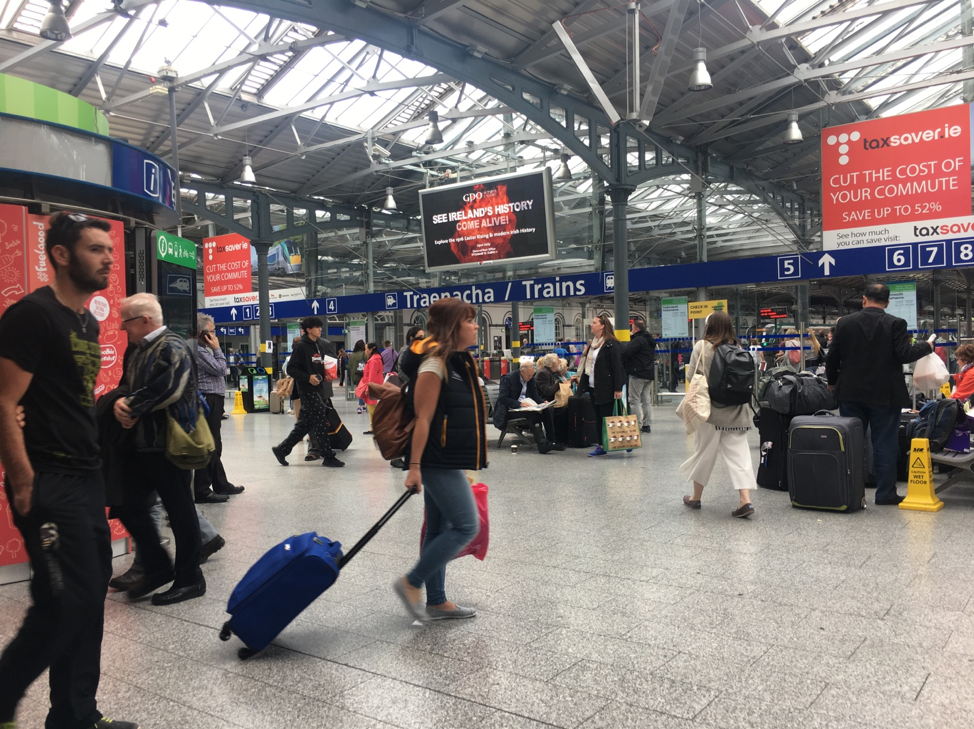
If you are trying to get to across the country, use the train! We took the train from Dublin to Galway and it was so incredibly easy and a very nice train ride as well. The train is very clean, with tables and comfortable seats. I would highly recommend heading over to Galway for a weekend by train! You should book these tickets ahead of time if you want to sit with friends. Our tickets to Galway were about €25 round trip. I know you can get to Cork and Belfast on the train as well so definitely check out the train for a few weekend trips!
These are the easiest and cheapest ways to get around Dublin and the rest of Ireland! Take advantage of all the time you have and travel the country because it has so so much to offer!

Grace Heart studied abroad in Dublin, Ireland, in Summer 2017: http://eap.ucop.edu/OurPrograms/ireland/Pages/science_engineering_summer_uc_dublin.aspx
BY WILLA GIFFIN
Ciao!
I’m back from what feels like a very long one-week blogging hiatus. Life has been wonderfully busy, where even the dullest moments (like taking out the trash) are filled with profound beauty and endless exploration.
I wasn’t able to write last weekend because I was sans computer in the Swiss Alps having the most exhilarating, fun-filled, picturesque, three days that I’ve had thus far in my life.
With a group of friends, I took an eight hour bus ride to Interlaken, where we gobbled up mounds of authentic fondue, learned to make chocolate at a cooking school (and quickly devoured that too), sledded forty-five thrilling minutes down an enormous mountain guided only by moonlight, visited Zurich, took a hike, stumbled upon ancient German ruins, and…wait for it… paraglided through the clouds over the incredibly stunning Swiss Alps. (I can barely stomach going down an escalator, so the thought of paragliding was absolutely horrifying to me… and also the best thing I’ve ever done).
After a phenomenal weekend away, I’m back in Florence, and like anytime I step foot outside of these city limits, I’ve returned with an entirely new prospective and appreciation for this unparalleled city. After Switzerland, I feel completely rejuvenated from that fresh mountain air, but I’m fondue-ed out, and ready to realign my loyalty with my beloved spaghetti.
Almost every weekend, I’ve travelled at least for the day and a night. There is a group mentality that I’ve picked up on amongst study abroad students here towards seizing every single moment so as to experience as much of Europe as possible (and sometimes even Africa). Every Monday the professors go around the class and ask, “dove siete andati durante il fine settimana?” (where did you all go over the weekend?). Responses never fail to include cities scattered across the entirety of Europe. It’s strangely easy to feel like staying in Florence is commonplace and even a little bit boring. I know… can you imagine?!
I am infinitely grateful to have been able to travel to so many fascinating places (Interlaken, Zurich, Rome, Pisa, Lucca, Verona, Venice, Siena, and San Gimignano). For many students, frequently traveling outside of Florence and experiencing the beauty that is Europe was the initial goal of studying abroad, however, for me, it wasn’t. My original objective was to spend so much time in Florence that I become completely and utterly enveloped and swaddled up tightly in the warm, welcoming, rich, aromatic, and tasty culture here.
This weekend I reminded myself of this intention, and was adamant about staying in this beautiful city that contains more than I could possibly see, experience, or eat in seventy-eight lifetimes.
…
Last night, it rained harder than I ever thought possible. I considered turning on my rain-sounds white noise app, just to cover up the natural, cats-and-dogs pelting rain outside.
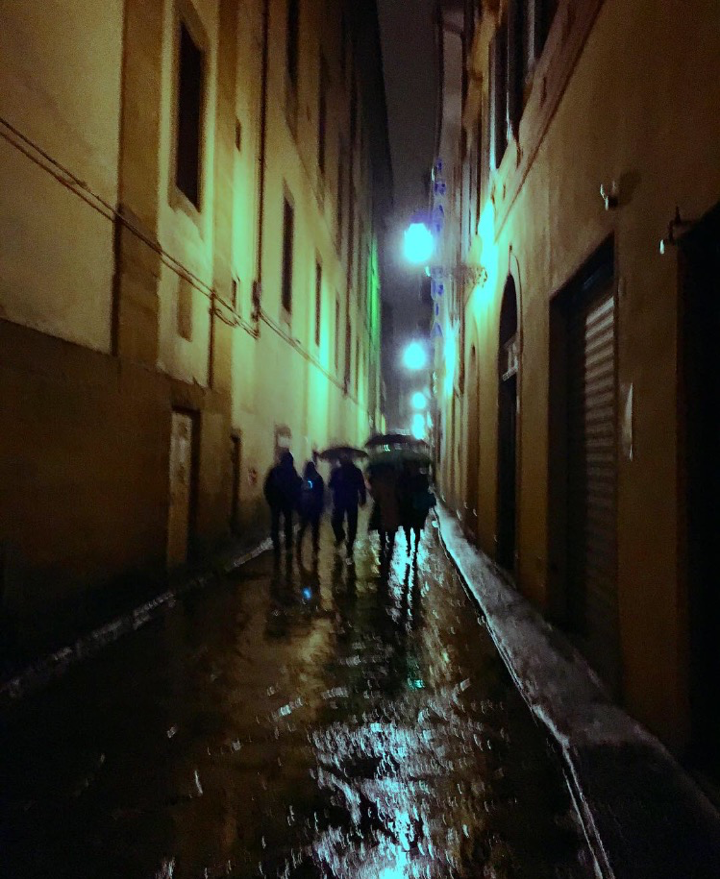
But this morning, I woke up to the most miraculously, crystal-clear, brilliant, blue Saturday sky. What a great day to be in Florence.
After making a quick breakfast at our apartment, Ruby and I decided that the garbage sitting under the kitchen sink had long past reached its expiration date. We gathered up our trash bags and took them outside where we dumped them in the city garbage receptors 300 meters away from our apartment (I’m trying to learn the language of the metric system).
That walk to the trashcans is one of my favorite parts of the week. We pass quaint gelaterias, hip bars, ancient buildings with antique terraces, incredibly innovative street art, and the unbelievable Santa Croce Church, which houses amazingly intricate frescos along with the tombs of Michaelangelo, Machiavelli, Dante, and Galieleo (not to name drop or anything).
Today, on our way back from dumping out the garbage, we decided to go inside the Santa Croce Church, instead of simply admiring it’s outside beauty from (the close) distance of our garbage cans.
Ruby had been in the Santa Croce before with her Art History class here, so she was able to spare me the time and energy of reading the explanatory plaques on the wall, and she gave me a condensed, more lively version of the most interesting facts about this 13th century church.
While I was admiring Michelangelo’s elaborately decorative and enormous tomb, a group of five monks asked me to take their photo on one of their iPhones. Not only did I get to learn about the incredibly fascinating and overwhelmingly exquisite history of the church, but I also learned that monks love selfies too!
When our stomachs began to rumble (as they seem to do about every twenty minutes here), we headed a few steps around the corner to La Prosciutteria, where met up with our friend Sofia. Ruby and I shared a decadent, artfully displayed board of prosciutto, salami, ham, several types of cheeses, roasted vegetables, olives, different breads, and some fig marmalade to top. This gluttonous feast was considered to be a “sampling plate” for two, but in reality it was so enormous, it could have fed my teenage brother.

Of course, lunch wasn’t complete until we got our gelato fix from Gelateria dei Neri (a place that was recommended in the Florence guide book my parents got me for Christmas). The three of us all ordered the “burro di caramello” flavor (butter caramel). It tasted rich and delicious like Werther’s Candy in ice cream form (aka heaven really is on earth, and it’s in a gelato shop right by my apartment).
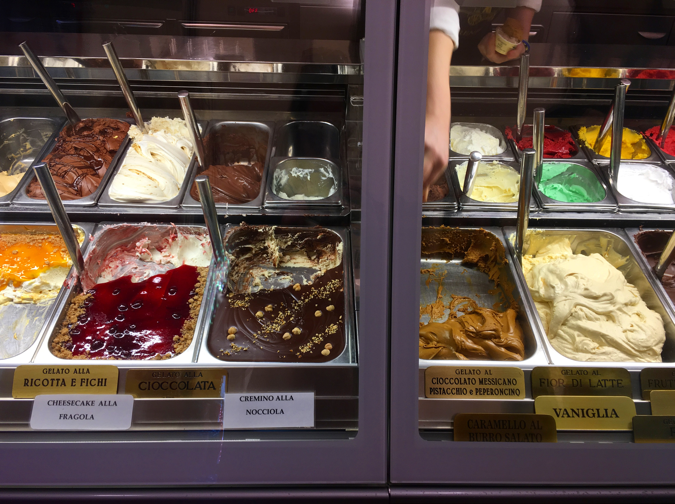
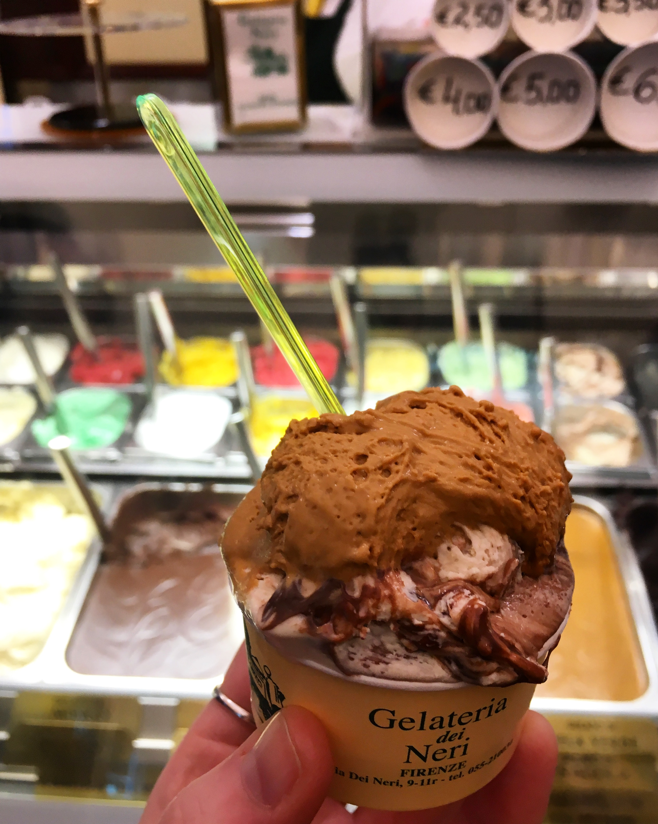
We tried to walk off our lunches with some good old-fashioned window-shopping. We wandered through the leather market, gawking over the artisan bags, and snooped through the chic racks of the Italian boutiques and department stores. Along the way we listened to street musicians and watched brilliant chalk artists create temporary masterpieces on the cobble stone roads.
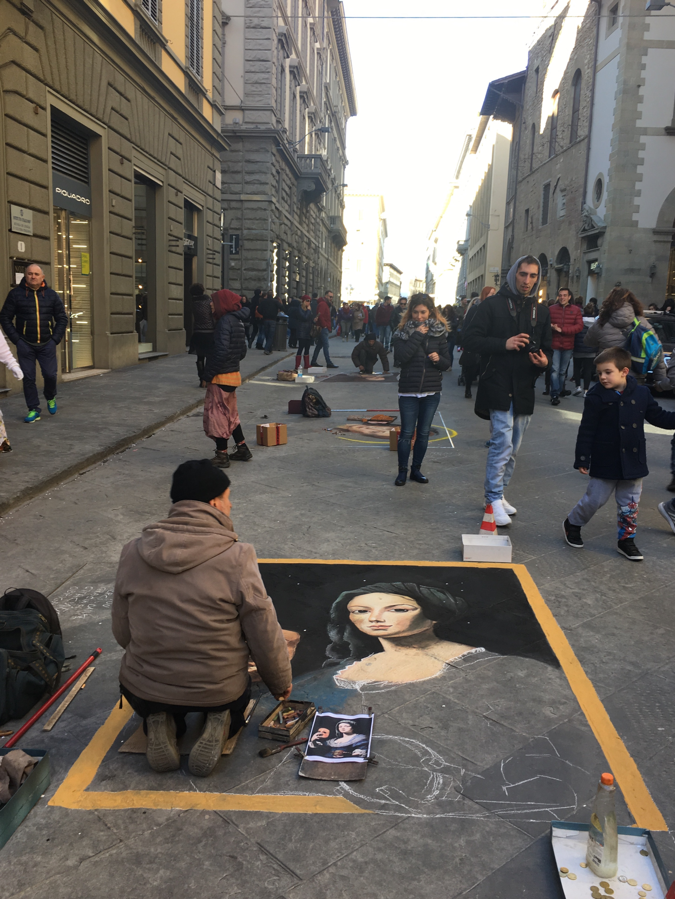
Somehow our shopping turned into yet another excuse for a snack break, as there was a coffee shop on the roof of one of the department stores (thanks for the recommendation Andrea!). We sipped on espressos and munched on our complimentary peanuts while looking out at the café’s breathtaking view of the Duomo, the cathedral in Florence and the most iconic monument in the city.
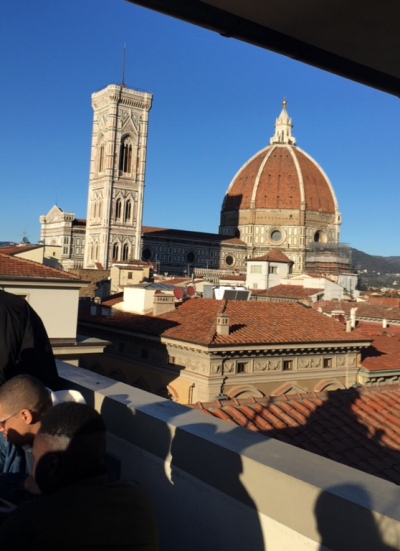
We attempted to climb to the top of the Duomo (where you get a panoramic view of Florence) but the lines were far too long, and we decided to wait until a weekday rolls around and all the tourists get out of our city 😉
We each went back to our apartments to regroup before we’d meet up for dinner later, where I’d indulge yet again in Florence–in another new restaurant, on a street I’d never walked down before, with waiters that could become future friends, and dishes that I hadn’t yet tasted that could very well be my new favorite meal.
Florence, what more could I ask for?
Willa Giffin studied abroad in Florence, Italy in Winter 2017: http://eap.ucop.edu/OurPrograms/italy/Pages/language_culture_florence_quarter.aspx
BY BARRY YANG
“C’est bon” (it’s good). No two words could better encapsulated and de- scribe my first week in France. This is because these two words are the ones I use the most from my arsenal of flowery French vocabulary: filled to the brim with all its 10 words and elementary sophistication.
I have never taken French before. I have never been to Europe. I have never been so excited.
Coming to a foreign country and not understanding anything may seem scary, but at the end of the day it all comes down to perspective. When I first moved to the US at age 8, I was dropped straight into 2nd grade not speaking a word of English. At that age I was too naive to under- stand embarrassment or comprehend the fact that the teacher did not speak Chinese (I completed all my assignments and gave presentations in Chinese and never thought about the difficulties Mrs. Turner would have). Now, at 21, I am still very much possess that adolescent naiveté and could not be more thankful and happy that I never truly matured in this area. It is this youthful ignorance and complete blindness to bar- riers that has made my time in France, thus far, “très très bien” (very very great). I could not be happier that I never learned as a child to not talk to strangers.
Without any previous experience in French, I dove head first into this beautiful land. Armed with one phrase and one phrase only, “parlez- vous anglais” (do you speak English?), I landed in Lyon on New Year’s Eve at 10:17PM. Completely clueless and shocked by the freezing cold, I managed to get myself to my hostel after 1 train, 2 trams, and a lot of directions from Frenchmen that I couldn’t understand. I arrived at my Hostel exactly at 12:00AM and was greeted by a huge group of people with “bonne année” and other trendy French New Year sayings that I did not understand. It was at this moment that I realized that the hos- tel I had so last minute booked on Expedia was also a bar…The night continued with random conversations with a group of locals who in- vited me for drinks and made sure that I did not have to spend the first moments of 2017 alone. Everything that I had heard about the French hating Americans and being extremely unfriendly were all proven to be complete and utter BS at this moment. Thank you Mohammed, John- Phillip, and all the others with really French names that I do not have the proper education to pronounce.
(Six hour layover in Amsterdam before arriving in Lyon, France)
1) Lyon Airport. 2) Closing in on New Years. 3) Rhone Express to Lyon city center. 4) Friends I made on New Year’s Eve
I spent the next 2 days at the hostel and got really close with the baris- tas and other travelers who shared with me some special local spots and their incredible stories. One gentleman from Australia was espe- cially memorable. Jonathan had been an engineer in Australia and at the age of 48 decided to quit his job and travel the world. On the date that I met him, he had been traveling for almost 2 years. We talked late into the night, and his experiences and stories inspired and made a last- ing impact on me. He didn’t have a lot of money nor many luxuries, but one could feel the appreciation he had for life and the vitality he pos- sessed. Thank you Jonathan, Leslie, Judith, Clara, Sharif, Andre, and Jean for such a great first hostel experience in France.
On the 3rd day my host family picked me up from the Hostel and helped me move into my home for the next 6 months. When I met them, I could not believe how much my life was beginning to resemble a movie. My host-dad Yvan, is one of the most charming and funny people I have ever met and everything I imaged a Frenchman to be. We’ve had great conversations about how to strategize bargains with people on Lyon’s version of Craigslist (Leboncoin) and his favorite French musicians that I have grown to like. My host-mom Caroline, is very sweet and extremely caring. Her square glasses, French accent, and warm expressos just conjures up flashes of every French movie I have ever seen. Their children Paul-Eliot and Lison are also some of the nicest and most entertaining people I have ever met (child or adult). I could not have been more blessed to be placed in such a wonderful family. Even though we don’t always 100% understand each other, there is never a lack of conversation, great food, aromatic cheese, and terrific wine. Thank you guys for opening your home to me and wel- coming me as a member of the family.
Besides roaming the streets and talking to random people like a 7 year old, I’ve also dabbled in the realm of education. After all, academics first right? Classes have not officially began yet, but as a part of the pro- gram we have to enroll in a 2 week intensive French language and cul- ture seminar. The classes in this seminar are all in French. I’m not talking 1 or 2 words in French, a sentence in French, or even half an hour in French. I’m talking 6 hours a day of non-stop French. We’re not talking about elementary level French either. This is some next level, Les Misérable, Amélie, drowning in French type of level. I understand completely nothing in any of the classes. I live for moments when there are words spoken that sound similar to English and short breaks when I can converse with other students in a language that I actually know. Despite my efforts to transfer to a elementary school that I believe would actually be more conducive for my French learning, the powers that be have yet to honor this request.
This past week in the classrooms have been very reminiscent of my first months in 2nd grade when I didn’t speak a word of English and could not understand anyone. Similar to those months 13 years ago, I am still proceeding with a blissful lack of concern and regard for the language barrier and childishly engaging in the ways I can and to the best of my ability. Despite me being eons behind everyone else, these classes have proved to be overall great experiences and I don’t hesitate for a second on whether I should go to class tomorrow. After all, decisions are not made by everyone who understands, but can only be made by those who show up.
(A field trip organized by the University as part of the language program. We got to spend a day in Montpellier, which could have literally been the setting for every single Hollywood romantic film.)
I’ve made friends with the staff and professors who have come to refer me as the class’ collective “baby” and also graciously made accommoda- tions to make things a little easier for me. Although I still understand nothing, I have come to learn through this past week that it is not so much how much you can understand, but rather how much you try to understand that really matters.
I have made some great friends from all over the world in these classes. They are some of the most kind and fun people to be around. It’s amaz- ing how close we all have grown in such a short amount of time and I can not thank them enough for their help and friendship. Thank you: Jonathan, Daniel, Claire, Stasi, Cian, Ollie, Tammy, Elishka, Flevie, and Madam Santos for being the A1’s and all the great times. Looking for- ward to all the possibilities in the 6 months.
Some wonderful instructors who made things very fun even though I understood nothing they said 100% of the time.
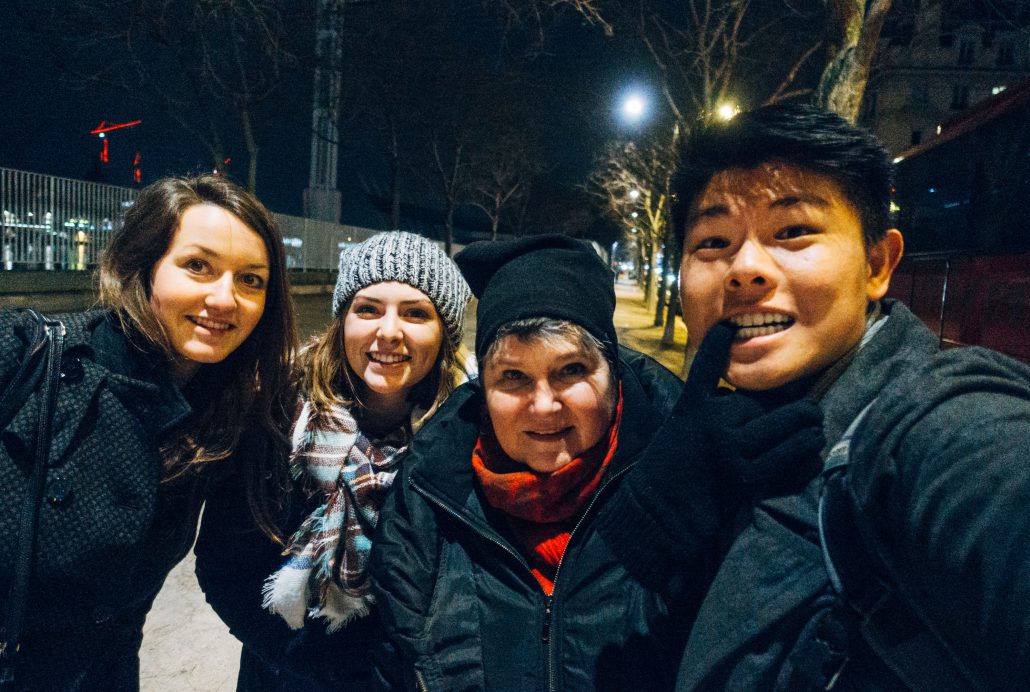
(Some extremely fun times shared with some great people. Could not have asked for better compadres on this journey through a foreign land.)
In the words of Hannah Montana: “life’s what you make it, so let’s make it rock.”
Barry Yang studied abroad in Lyon, France, in Spring 2017: http://eap.ucop.edu/OurPrograms/france/Pages/default.aspx
BY PARIS SUMPTER
Paris has her first day of Japanese language classes at International Christian University.
Paris Sumper studied abroad in Tokyo, Japan, in Summer 2017: http://eap.ucop.edu/OurPrograms/japan/Pages/language-and-culture-ICU.aspx
BY CELIA CODY-CARRESE
Living in another country is a wonderful experience full of new friends, new experiences, and travelling to new places. It’s also challenging, and it requires you to adapt to new circumstances. Moving to a Spanish-speaking country to study the language is a lot different than taking a class at a UC. From an academic and immersive perspective, here’s what I’ve learned.
Attending university in Córdoba has been very different from my regular college life at UCLA. At UCLA I go to a large university where everything is located on one campus. The University of Córdoba has different buildings throughout Córdoba, which each serve different groups of students. I attend classes at University of Córdoba Idiomas (Languages), or UCO Idiomas. One of the biggest differences between UCLA and UCO is that classes are much smaller in Spain. My biggest class here, Spanish History, has all 27 students in my program; but my Spanish Language and Andalucían History classes both have 15 students or less. At UCLA, my smallest classes (not including discussions) have about 60 people. Having smaller classes is a nice change, and I really feel like I know my professors- they are all very kind and funny, and attentive to the needs of students.
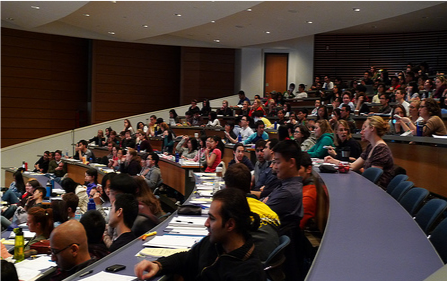
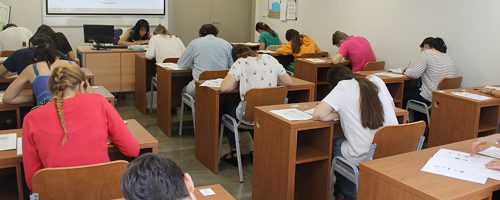
(An average class at UCLA vs. UCO Idiomas)
Teachers here generally teach in a different style- only one of my professors uses a prepared Powerpoint for his lectures. Another professor uses maps and images sporadically, but he mainly just lectures and writes on the whiteboard. Additionally, all of my classes here are taught in Spanish! The Andalucían History class, which is an elective, was originally taught in English, but we opted to have our professor speak Spanish. It has been a good way to practice and fully immerse while at school, and he is able to get his lessons across easier by speaking in his native language. At first I was worried about having History classes in Spanish- I figured I would not be able to understand enough, and would be ill prepared for the test. However, understanding another language is one of the first steps of language acquisition (it comes easier than speaking), so within a few weeks I was understanding most of what my professors were saying!
My schedule here is also a big shift from university life. In a normal quarter I also take three classes, which are spread out throughout the week- so I might have two classes on Tuesdays and Thursdays and one on Mondays and Wednesdays. I often have days with big gaps in between classes, and my days can change a lot depending on my academic and extracurricular schedule. Here from from 9:30 to 11:30 I have Spanish class Monday through Thursday, and from 12 to 2 I have Andalucían History on Mondays and Tuesdays, and Spanish History on Wednesdays and Thursdays. Every day we have a half hour break between classes, which is much needed time to recharge with a snack! On Fridays, we go on trips to historical and cultural sites in Córdoba and around Andalucía. Having class at the same time everyday is a big adjustment- I haven’t had a schedule like that since high school! While part of me misses the flexibility of having days off or big gaps between classes, I also really like the routine of waking up at the same time everyday.
There’s a cafeteria right across the street from UCO Idiomas, and I often have café con leche y tostada con tomate (a latte and toast with a tomato spread) for a snack during our break.
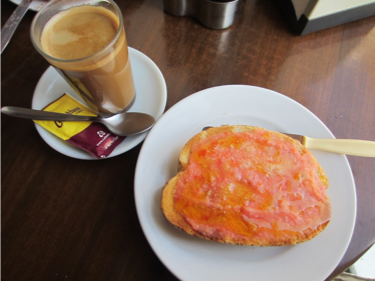
Another big difference here is the way grades and classes are structured. There is less work consistently given out, and more of your grade depends on testing. I have daily homework for my Spanish class, which usually takes me about 30 minutes to an hour, and most days I study more Spanish on my own. For the history classes I don’t have homework, and pretty much my entire grade depends on testing. My program is divided into Spring Semester students (who are in Córdoba until May) and Winter Quarter students (that’s me) who are here until March, and then returning to our schools for Spring Quarter. When we take our finals, the Semester students are also testing, but for them it is their midterms. Besides my Spanish class which also incorporates written assignments, my grades are based solely on testing and participation. It’s a little nerve-wracking, having your grade centered on one test, but I’m not too worried about the tests. One advantage of being a Quarter student in my program is that all your tests (except for Spanish, of course) are in English!
Your brain, on language acquisition.

Studying abroad, especially when you are learning a new language, is a different type of learning because you are constantly absorbing new information and expanding your knowledge. You don’t just go to class, learn something, study it, and then go about your life. What you learn in class is reinforced by your life outside of university, and vice a versa. In my Spanish class we are encouraged to talk about what we did over the weekend and bring in new phrases we learned. In history we learn about Al-Andalus, the name of Andalucía when Muslims ruled and the European Caliphate was centered in Córdoba. We learn about the Catholic monarchy of Fernando and Isabel and how they expelled the Muslims from Spain. Walking through Córdoba or Granada, architectural examples of Muslim and Christian culture can be found everywhere. And most importantly, I am surrounded by Spanish all the time- in my homestay, in class, in the street. This makes understanding and practicing Spanish much more accessible, and it becomes part of your life faster than it would without immersion.
It takes years and years of practice to become fluent in another language. By living in another country for a few months, you will improve and learn a lot- but you won’t become fluent. However, by immersing yourself and making an effort to practice every day, you are bound to improve, and lay the groundwork for communicating in another language!
Celia Cody-Carrese studied abroad in Cordoba, Spain, in Winter 2017: http://eap.ucop.edu/OurPrograms/spain/Pages/exploring_andalucia.aspx
